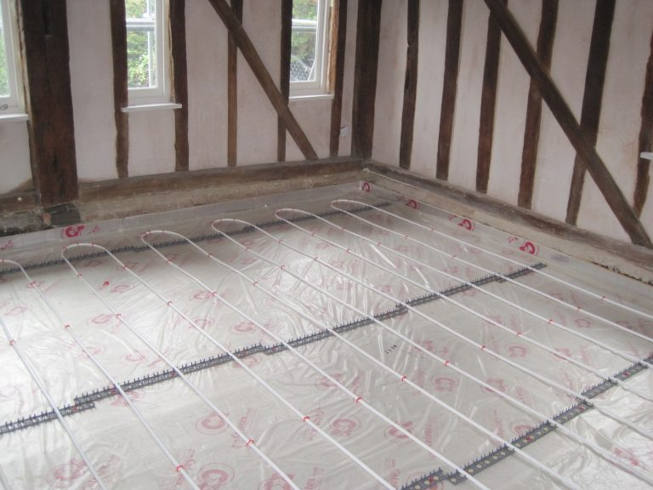Essex Barn Renovation – Under Floor Heating
Saturday, 18th January 2014
Case Studies
If you’ve read the previous posts in this series you’ll know that the renovation was split in to 2 phases; effectively dividing the barn down the middle. Since the last post was uploaded phase 1 has been largely completed so we’ve swapped sides with the builders. Even though phase 1 overran by about 5 weeks I’m still told that the work will be completed by Christmas so it feels like we’re on the home stretch.
Although we’ve been living the completed phase 1 for a few weeks now the heating was only switched on this week so the relatively mild weather has been very welcome.
As we were starting from scratch as far as the services were concerned we considered a number of alternative heating systems but under floor heating seemed the most appropriate; for 2 reasons that were specific to the property:
The structural oak beams are visible in every room and in some rooms on 3 walls. It would have been a shame to interrupt their flow with wall hung radiators.
Some of the rooms have very high ceilings which makes them difficult (and expensive) to heat. The type of under floor system that we have runs at a relatively low temperature meaning that the heat is more likely to stay where you want it; close to the ground.
As I say, these were reasons specific to the barn but there are other benefits to installing under floor heating:
In contrast to radiators which provide heat from fixed points within a room an under floor system heats the whole floor area. The result is a more consistent room temperature (and warm feet which is nice!).

Because the system runs at low temperature it can be successfully combined to work with heat pumps. Our system is powered by 2 ground source heat pumps located in a plant room to the rear of the property. The heat pumps can provide domestic hot water at 60˚C while running the under floor heating at a more efficient 40˚C. A heat pump extracts heat from the outside air in the same way that a fridge extracts heat from its inside. The heat that they extract from the air (or ground) is constantly being renewed naturally.
The Government will pay householders to use renewable energy sources, such as heat pumps, when the Renewable Heat Incentive is introduced; likely to be in 2014. In the meantime you can apply for a one off grant toward the installation costs.
Underfloor systems will generally require less maintenance. Before the pipes are screeded over they are tested to approx. 10 times operating pressure so that any potential leaks can be identified at an early stage and heat pumps require less maintenance than traditional boilers.
An underfloor system produces less airborne dust than with radiators and their convection currents which is a real benefit for asthma sufferers or people with allergies.
We’re also using underfloor heating upstairs which is a suspended timber floor; it gets housed in a tray which sits between the joists. Floor coverings will be a mixture of timber boarding, carpet and ceramic tiles so it really is very versatile.
All being well, we’ll have moved on to the interesting part of phase 2 by the time I write the next post in this series.
